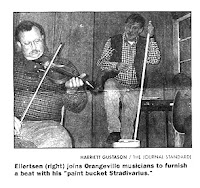Although we like to imagine the "deep and dreamless sleep" of a little village while "silent stars go by," Bethlehem today is a crowded tourist destination of 28,000 in the West Bank territories administered by the Palestinian Authority. While its tourism has been adversely affected by the troubled political situation in the Middle East, it has been a Christian shrine since 327 AD when its Church of the Nativity was commissioned by the Roman Emperor Constantine.
So it should come as no surprise that a recent flash mob video commissioned by the Bank of Palestine and the Bethlehem Development Foundation would be a lively, upbeat, professionally edited marketing piece. Its production values compare well with American ad agency work, and it pictures Bethlehem as people in Bethlehem might wish to be pictured.
The music is pretty darn good, too, on a par with the best gospel and Christian contemporary in Europe and the United States.
How silently, how silently / The wondrous gift is given!
Instead of the pastoral quiet of "O Little Town of Bethlehem," the video shows a polished performance by Fouad Moubassaleh and other Palestinian pop singers of "Oh Happy Day" and the Christmas carol we know as "Angels We Have Heard on High," both in Arabic, in Manger Square. Located between the Church of the Nativity and the Mosque of Omar, with the Bethlehem Peace Center on a third side of the square, it is a focal point of Christian ceremonies -- and therefore of the tourist industry.
Here's the video:
Bethlehem Christmas Hymns © تراتيل ميلادية في بيت لحم | Flash Mob. A flash mob that took place in the Manger Square in Bethlehem, Palestine, after the Sunday Mass Dec. 21 in the Church of the Nativity & Saint Catherine Church. [St. Catherine's is the Catholic church included in the Church of the Nativity complex.] Produced by H2 Media Studio of Bethlehem. Organized & Sponsored by:Bank Of Palestine | http://tinyurl.com/bankofpalestine
Bethlehem Development Foundation | http://tinyurl.com/bdfoundation
Performers:
Amjad Khair | أمجد خير
George Thaljieh | جورج ثلجية
Steve Hana | ستيف حنا
Fouad Moubassaleh | فؤاد مبصلة
Jacob Shaheen | يعقوب شاهينMusic Production:
RJ Music Productions / John Handal | جون حنضل
Live Sound/PA:
Scottish Center/ Richard Hanania
Production: H2 Media Studios © All Rights Reserved 2014 | H2 Media Studios
H2 Media Studios (Philip Hihi and Francis Hihi) is a photographic equipment and services business located in Bethlehem. Facebook page at https://www.facebook.com/h2mediastudio. On Palm Sunday in April they did a similar flash mob performance in Manger Square. The song was in Arabic, and the melody wasn't familiar to me.
Promoting international tourism on the West Bank remains an uphill battle.
For a variety of reasons, tourism is way down this year. In an Associated Press color story filed Wednesday, Daniel Estrin of the AP's Jerusalem bureau said police and local officials estimated that 4,500 international tourists, "less than half last year's number," visited the Christmas eve celebration in Bethlehem this year:
The central Manger Square was decked out in white and yellow lights and a towering Christmas tree. On a cool, clear night, there was a carnival atmosphere: Vendors hawked corn, candied apples, watches, and balloons in the shape of cartoon characters.Scout troops played bagpipes, horns and drums, and bands from around the world performed on a stage, singing Christmas carols and original Christmas rock ballads, mostly in English. A recording of "Feliz Navidad" blasted through the speakers, too. A Palestinian host welcomed members of Gaza's tiny Christian community, who were permitted to cross through Israel to the West Bank, eliciting whistles and applause.
Other reminders were not absent of: (1) Bethlehem's precarious political situation; and (2) the commercialization of Christmas.
Estrin of the AP added, "The Church of the Nativity, built over the grotto that Christians believe is the site of Jesus' birth, was flanked by the towering Christmas tree and a large poster in Arabic and English that read 'All I want for Christmas is justice'."
Turns out I've been posting Christmas clips to the blog ever since I visited Bethlehem in November 2012:
- http://hogfiddle.blogspot.com/2013/12/christmas-in-bethlehem-scout-parades.html -- last year's TV coverage of the religious ceremonies and scout parades, inspired by the British during the Palestine mandate but now a Palestinian tradition.
- http://hogfiddle.blogspot.com/2012/12/bethlehem-christmas.html -- still more coverage of the parades and ceremonies, in 2012.
- http://hogfiddle.blogspot.com/2012/11/christmas-lutheran-bethlehem.html -- worshiping in Arabic and English at Bethlehem Christmas Lutheran Church.
- http://hogfiddle.blogspot.com/2012/12/holy-land-1-of-church-of-nativity-with.html -- my thoughts on visiting the Church of the Nativity, which totally blew my mind.















